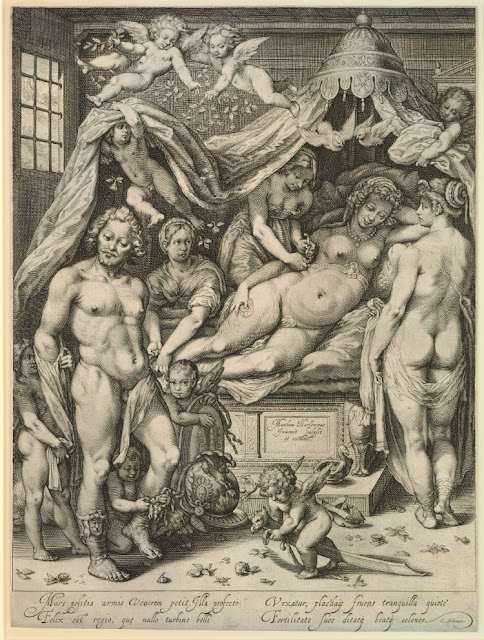 |
| Jacob Matham Mars and Venus undressed by attendants ca. 1600 engraving British Museum |
The Fourth Song
Ye should stay longer if we durst;
Away, alas that he that first
Gave time wild wings to fly away,
Has now no power to make him stay.
But though these games must needs be played,
I would this pair, when they are laid,
And not a creature nigh them,
Could catch his scythe as he doth pass,
And cut his wings, and break his glass,
And keep him ever by them.
– Francis Beaumont (1584-1616)
 |
| Alessandro Casolani Venus and Cupid before 1606 drawing British Museum |
 |
| Lucas Kilian Grotesque panel with Venus and Adonis 1607 etching British Museum |
 |
| Bartholomeus Spranger Venus and Cupid before 1611 drawing British Museum |
 |
| Peter Paul Rubens Venus lamenting dead Adonis ca. 1612 drawing British Museum |
Sonnet
As, in a dusky and tempestuous night,
A star is wont to spread her locks of gold,
And while her pleasant rays abroad are rolled,
Some spiteful cloud doth rob us of her sight;
Fair soul, in this black age so shined thou bright,
And made all eyes with wonder thee behold,
Till ugly death, depriving us of light,
In his grim misty arms thee did enfold.
Who more shall vaunt true beauty here to see?
What hope doth more in any heart remain,
That such perfections shall his reason rein,
If beauty, with thee born, too died with thee?
World, plain no more of love, nor count his harms;
With his pale trophies death hath hung his arms.
– William Drummond of Hawthornden (1585-1649)
 |
| Giovanni Battista Pasqualini after Guercino drawing, now at Chatsworth Venus and Adonis with Cupid 1620 engraving British Museum |
 |
| Giovanni Luigi Valesio Venus whipping Cupid with bunch of roses, restrained by Satyr before 1633 etching British Museum |
 |
| Nicolas Chaperon Venus and Bacchus conversing 1639 etching British Museum |
 |
| Cornelis Schut Venus and Cupid before 1655 etching British Museum |
 |
| Stefano della Bella Costume-design for Venus in Francesco Cavalli's opera, Hipermestra ca. 1658 drawing British Museum |
Francesco Cavalli's opera Hipermestra debuted in Florence in 1658. It was successfully revived during the recent summer season at the Glyndebourne Festival by William Christie. Aside from a smaller festival production in Utrecht in 2006, the work had not been staged since 1680.
 |
| Giovanni Pietro Possenti Venus embracing Cupid while Satyr with neck-halter is pulled away ca. 1640-60 etching British Museum |
 |
| Augustinus Terwesten Venus lamenting dead Adonis ca. 1670-80 etching British Museum |
 |
| Wenceslaus Hollar Venus and Cupid appearing in clouds to soldier and woman (book illustration for The Ephesian Matron by John Ogilby) 1673 etching British Museum |
 |
| Wenceslaus Hollar Venus and Cupid among clouds (book illustration for The Ephesian Matron by John Ogilby) 1673 etching, heavily and clumsily colored with red ink British Museum |
The Ephesian Matron, or, Widow's Tears, illustrated directly above, was published in Æsopicks, or, A Second Collection of Fables, paraphras'd in verse, adorn'd with sculpture, and illustrated with annotations / by John Ogilby, Esq., his Majesty's cosmographer, geographic printer, and master of revels in the kingdom of Ireland. Ogilby based the text of his verse translation on a prose episode, The Widow of Ephesus, from The Satyricon (1st-century Latin novel by Petronius). The theme of the story is "female inconstancy," hence the association with Venus, benefactress of lovers.